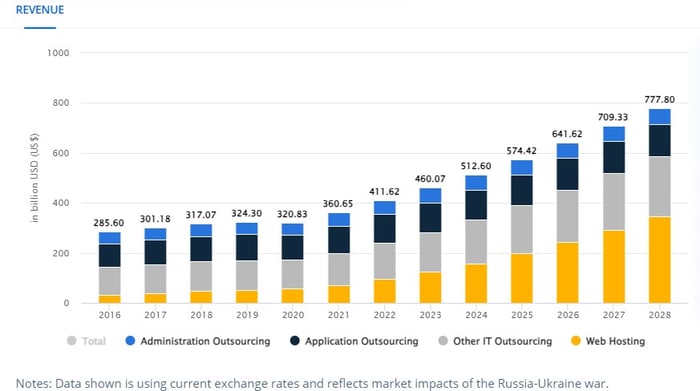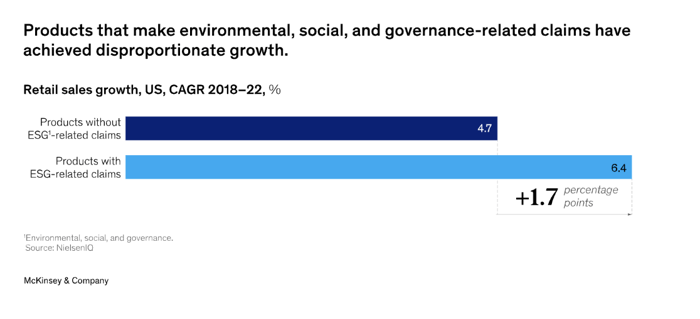10 IT Outsourcing Trends to Follow in 2024 and Beyond

In the economic downturn we’re facing, efficiency and adaptability are the keys to maintaining profitability and navigating the hard times. Most companies are learning the hard way that staying flexible in scaling the team is crucial to maintaining business profitability.
In Q1 of 2024, more than 49,000 tech employees were laid off – and that’s on top of the 262,995 who lost their jobs in 2023.
The answer to market uncertainty and cost optimization is outsourcing, all without having to go through the lengthy hiring processes.
Below, we'll explore the latest IT outsourcing trends and the ways they can support your business.
The evolution of IT outsourcing
The roots of IT outsourcing can be traced back to the 1980s and 1990s, when companies such as Kodakoutsourced parts of their business processes in search of cost-effective solutions. Thirty years later, outsourcing has become a common strategy utilized by companies seeking time and cost savings, skilled professionals, and tailored solutions.
Nowadays, outsourcing is not only about saving money. Businesses increasingly rely on it as a strategy to gain a competitive advantage by bridging expertise gaps and technological lapses.
Outsourcing enables businesses to overcome geographical constraints and access specialized skills around the world.
All while delivering actual cost savings – proven by research such as thatprovided by Yegor Denisov-Blanch for Stanford University. By replacing 42 Bay Area engineers with 41 in Poland and 5 in India, the studied company reduced their annual engineering spend from $12.3 million to a staggering $7.4 million.

Source: Yegor Denisov-Blanch, Stanford University, Ongoing Research on Developer Productivity
Outsourcing industry by numbers
The outsourcing market is reaching an all-time high and appears poised for further growth. The outsourcing statistics speak for themselves.
Below, you'll find some of the most interesting numbers regarding the market and outsourcing companies.
- 92% of G2000 companies are using IT outsourcing (IGS).
- Executives identified cybersecurity as the number one external challenge they face in achieving their strategic objectives. In 2022, 81% of them turned to third-party vendors to help them expand their cybersecurity capabilities (Deloitte).

Source:Global outsourcing survey 2022, Deloitte
- The global IT outsourcing market size is expected to reach $1.18 trillion by 2030 (Grand View Research).
- In 2023, spending on IT services was projected to amount to around $1.42 trillion worldwide (Statista).
- The revenue of the outsourcing market in 2024 is estimated to reach $512.47 billion (Statista).

Source:Revenue of the IT outsourcing market worldwide from 2019 to 2028, Statista
- The three biggest areas of outsourcing include web hosting, administration, and application outsourcing (Statista).

Source:IT Outsourcing Worldwide, Statista
Key trends in IT outsourcing
Thanks to new technology, outsourcing is helping businesses solve problems by cutting costs without sacrificing quality. This approach is crucial during hiring freezes and budget cuts, ensuring projects are completed quickly and can grow as needed.
What outsourcing trends are coming, and how will they affect you? Most importantly, how can they help your situation?
Get to know these top ten IT outsourcing trends and find the ones worth applying to your business processes.
1. The future is data-driven
Adapting to new business norms will hinge on data analysis. During layoffs, companies are realizing how essential good resource management and predictive analytics are.
In the landscape of business uncertainty, data-driven decision-making (DDDM) will be the key to making smart business choices. In this context, strategy becomes the ability to say no, yet all "nos" must be confirmed through a data-driven approach.
Many companies will turn to outsourcing with third-party providers as a solution to their changing hiring and expertise needs. By doing so, businesses ensure they are not just responding to immediate needs but are making data-backed choices that align with their goals.
2. Artificial intelligence is taking over
...well, at least in some ways.
AI is not just another outsourcing trend. Artificial intelligence will take center stage in the technological revolution that accompanies automation, making the promise of automating specific functions even more tangible.
Both artificial intelligence and machine learning will become invaluable technologies in many business processes, including predictive analysis, customer service, and software development. With the growing pressure for time savings and operation optimization requirements, AI and ML address these challenges.
When choosing outsourcing partners, their ability to incorporate AI and ML into operations will soon become one of the deciding factors.
3. Robotic process automation (RPA) to the rescue
In 2022, the robotic process automation (RPA) market's growth rate reached 22%, which, as stated by Gartner, means RPA is entering its early maturity stage.
Robotic process automation will continue to gain momentum as it offers core teams the freedom to focus on the most important parts of the business by relieving them of tedious, time-consuming tasks. The technology can help with almost any repetitive action – from general back-office tasks to testing and data migration.
Offering the potential to hyper-automate, robotic process automation will be an interesting efficiency booster for software engineering teams.
4. Cloud-native and multi-cloud outsourcing services are gaining ground
Cloud computing is no new subject to tech-savvy businesses. Leveraging the cloud allows companies to scale and adapt to growing market demands.
Now, as multi-cloud strategies gain traction, the role of cloud services in IT outsourcing partnerships will grow, especially given its role in risk management and redundancy enhancement.
5. Hybrid is the way to go
Having said that, not all businesses will go all-in when it comes to cloud computing. For these businesses, a hybrid infrastructure will be the best approach, and like cloud-native outsourcing, hybrid outsourcing will also become more common.
For many organizations, the hybrid approach is the best way to attain data security and protect sensitive data while avoiding cyber threats and data breaches, all while accomplishing the much-needed scalability that comes with the cloud.
6. Low-code software development drives business growth
The adoption of low-code techniques allows businesses to automate processes and deliver products much faster, as evidenced by the usage of low-code.
According to Statista, the worldwide low-code platform market revenue was valued at almost $22.5 billion in 2022 and is predicted to reach approximately $32 billion in 2024. At the same time, Gartner estimatesthat, by 2025, 70% of applications developed by enterprises will be built with low-code or no-code technologies, up from less than 25% in 2020.
As the demand for low-code solutions grows, so will the number of companies looking for outsourcing providers with low-code capabilities.
7. AI-driven experimentation and PoCs will bring competitive advantage
Building at scale is out; experimenting is in. Developing a proof of concept instead of a full-blown product is the way to go in 2024.
Testing the market with minimum viable products (MVPs) is a good way to minimize the risk of spending money and resources on developing a solution with little or no real value.
Outsourcing providers can expect more and more experimental projects on their hands, especially those that require incorporating AI-driven technology.
8. Co-pilots are professionals' new virtual assistants
Another outsourcing trend involving the use of AI is the wider adoption of co-pilots. AI-driven co-pilots will become important tools for streamlining the process of product design and development. According to research, using artificial intelligence as a software development assistance tool increases productivity by about 55.8%.
The same goes for design—faster UI prototyping will greatly improve the efficiency of UX and UI teams.
The time and cost savings coming from introducing co-pilots to these business processes will definitely impact the outsourcing industry in the upcoming months.
At Netguru, we're already implementing various AI-powered tools that can raise team productivity and boost cost efficiency.
Our R&D team has, for example, experimented withLocofy—a design-to-code conversion tool. The solution is said to streamline the process of frontend development, accelerating project timelines. Our trial run has proven that utilizing the tool can lead to up to a 3x faster turnaround in development.
We've also tried and tested AI development programs for code generation to find the most effective one. For starters, we analyzed GPT-Engineer, Smol-Dev, MetaGPT, AutoGPT, ChatDev, and GPT-Pilot.
Our teams evaluated each one based on generated code quality, interactivity, ease of use, and overall user experience. We, once again, found that some of them—especially GPT-Engineer, in the hands of experienced programmers, can greatly streamline the process and shorten overall project or service delivery.
9. XR as the next big thing
Move over, AR/VR. 2024 is all about XR.
XR, standing for Extended Reality, is an immersive solution that combines the best of augmented and virtual reality. XR is set to play a fundamental role in the evolution of the metaverse. From gaming and retail to health and training, XR will essentially become an extension of many businesses.
The launch of the Apple Vision Pro has brought 'spatial computing' to the forefront, sparking commercial interest in adopting these technologies. Outsourcing companies offering industry-specific XR expertise will be invaluable to businesses looking to enhance their customer experience with Extended Reality.
10. Sustainability in the spotlight
Another interesting one of the top IT outsourcing trends is going green.
Interestingly enough, it's not only to stay in line with regulations such as The Green Deal Industrial Plan and avoid legal repercussions. Being more environmentally friendly is becoming increasingly important both for outsourcing businesses and consumers.

Source: A joint study on brand sustainability, NielsenIQ, McKinsey & Company
At the same time, outsourcing service providers are also looking for ways to make their operations greener. This will include a number of actions—from encouraging remote work to introducing new green technologies.
Responsible practices, energy-efficient infrastructure, and greener IT solutions will all be key factors in fulfilling businesses' sustainability objectives.
Expert insights on IT outsourcing trends
How are companies approaching mentioned trends in their business processes? What is the biggest trend of them all according to experts?
"There will be a growing trend towards outsourcing AI and ML development and integration, driven by the need for operational efficiency, advanced data analytics, and innovative product features," said Damian Sosnowski, the Head of Engineering at OLX, in the “0 to 100: Challenges a Head of Engineering Has to Face in 2024” episode of our podcast. "Businesses will look for outsourcing vendors that can not only perform tasks but also drive innovation, similar to how OLX empowers teams for ownership and innovation. This involves a shift from transactional outsourcing relationships to strategic partnerships."
Rams Chowdary, the Senior Director of Software Engineering from Delivery Hero, is also optimistic about artificial intelligence's role in transforming industries by improving efficiency and bringing to life new opportunities.
"And for sure, artificial intelligence is going to be bringing a lot of useful information, either strategy or like even implementations (...)," said Rams during our live event Beyond Code: Learning, Leading, and Innovating in Tech.
In Rams' opinion, by automating processes and providing customer insights, AI will influence several sectors—from trading and supply chains to e-commerce and online services. Rams also believes AI will not necessarily replace people at work but rather create new ways of working.
IT outsourcing trends: things to consider
Adopting some of these IT outsourcing trends may come with challenges.
As with any outsourcing contract, while implementing new ways of working and modern technologies, it's important to learn how to address potential challenges that may come ahead.
Combating IT outsourcing trends-related challenges
What can you expect while adopting the outsourcing trends, and how can you best manage the risks?
Ensuring quality and security
Trusting an outsourcing partner may not be easy at first, particularly if you're just starting to outsource. So, before your cooperation begins, make sure of a couple of elements.
Firstly, check whether your outsourcing provider, also known as the software development company, has the required experience and capabilities. It might not be that simple when it comes to emerging technologies (e.g., artificial intelligence or machine learning). In this case, examine their expertise in similar projects.
Secondly, ensure you and your outsourcing partner are aligned in terms of data privacy and data security. If your current data protection regulations differ, make sure you provide your business partner with all the needed information.
Building a strong partnership
This one isn't necessarily connected to the outsourcing trends per se, but it's a very important element of your outsourcing partners becoming your trusted allies.
To ensure seamless collaboration, whether it's an onshore or an offshore outsourcing partnership, transparent communication will be your best friend.
Remote work, time, or language differences between you and your service provider don't have to be a problem if your partner has the necessary experience and management practices in place.
Make the most out of IT outsourcing trends
Cloud services, artificial intelligence, RPAs, machine learning, and other outsourcing trends will definitely cause some positive disruption in the outsourcing market. In the challenging economic situation, applying these can provide businesses with the much-needed competitive edge.
Last year and the rapid development of AI-driven solutions have proven that technological progress is not slowing down.
Staying on top of the outsourcing trends and investing in proven software development companies can be just what your business needs to stay flexible and quickly adapt to the changing environment.







